Godzilla made his first US comics appearance in a legendary two year-spanning series at Marvel from Doug Moench and Herb Trimpe. The early issues represented a historic re-imagining of the character. Coming out before Toho re-invented Godzilla in 1984, they were the first rebirth of a “serious” Godzilla, in the wake of his zany ‘70s movies and his Hanna-Barbera cartoon. The editorial page of the first issue promises a return to the creature’s roots—“we are re-imagining Godzilla based on his 1954 appearance.” At Marvel, Godzilla took a parallel course as he seemed to do in nearly every movie series, starting out as a horrendous threat and ending up as a heroic friend to children (but still very dangerous). The difference here is, the seeds of his softening were deliberate and planted back in issue #1 with the series protagonist, Robert Takiguchi, who believed in Godzilla’s good heart when no one else would.
In 1987, Dark Horse obtained Godzilla as one of their very first licenses, just in time to capitalize on his ‘90s resurgence. Despite astonishing art (though sadly mostly B&W) and some cool only-in-comic moments like a multi-part time travel arc and a tussle with 20-ft-tall Predator ripoffs, a lack of strong foes or supporting characters left the run feeling rather unmemorable.
Flashforward to 2010: IDW (known by now for their strong line of G.I. Joe books in addition to popular original titles like Locke & Key) acquires the comic rights to Godzilla and, over the next three years, launch a series of wildly different books about the world’s most famous giant lizard. In anticipation of Gareth Edwards’ upcoming film, Deadshirt’s resident Kaiju Expert Patrick Stinson (with assistance from Jason Urbanciz and Max Robinson) walks you through the various flavors of IDW’s Godzilla comics (the good and the bad).
…
Godzilla: Kingdom of Monsters
Written by Eric Powell, Tracy Marsh and Jason Ciaramella
Art by Victor Santos and Phil Hester
IDW launched their Godzilla-verse with a bang. This series caught everyone’s attention right from the start, grabbing for the kaiju hat trick of humor, relevance, and spectacle. Importantly, IDW has the license for every Toho monster, so unlike Marvel and Dark Horse, they can put out a book that’s like Destroy All Monsters without budget limitations. While the excitement factor couldn’t have been higher out of the gate, though, the comic had a fundamental problem with tone; the central conceit of the series is that it has basically been “the real world” up till issue #1, when Godzilla shows up and starts massacring people.
Ambitiously, the series tries to depict the horrific consequences of a disaster of this scale, i.e. the first Godzilla. However, it also tries to satirize the real world even as it is tearing it apart. And, despite the often hilarious Eric Powell as the helm, it’s not a good satire. The book spends precious panel space tearing into Lady Gaga and Jersey Shore, relegating it forever to being a time capsule of the late ‘00s. Another attempt at topical hilarity comes when Anguirus destroys a border fence to the dismay of a conservative Texas governor, which I only wish I was making up. Combine that with the book’s fawning admiration of President Obama (er, “Ogden”) and it’s an insufferable portrait of a “center-left middle-aged white guy” creative team. The nadir of this sort of thing is when the book’s alleged hero, Steven Woods, deliberately leaves the Jersey Shore cast to die in the wake of a kaiju attack to the supposed satisfaction of the reader. Basically, the book’s not as funny as it thinks it is, and it can’t afford to be because it’s also whipsawing into “horrific collapse of civilization” territory.
However, we see improvement when Woods begins to shepherd an orphaned girl across the hostile landscape of post-kaiju North America. Additionally, the kaiju-related plotlines begin to converge as governments fight back and good forces start to buffer the forces of chaos. Most important of all, in its role as the flagship of IDW’s Godzilla offerings, the series “gets” the fundamental nature of Godzilla—on the human scale, he’s not truly an antagonist at all. He cannot be overthrown, only survived. In this way it largely escapes the fundamental temptation of Godzilla arcs to make the monster more relatable and heroic. At its best, Kingdom of Monsters concentrates on using the beasts to tell meaningful human stories, from the epic struggle of the United States to survive across the whole series, to the single-issue vignette of a grieving father who suicide-bombs Godzilla—and as we know it must be, the beast hardly notices.
Godzilla: Gangsters and Goliaths
Written by John Layman
Art by Alberto Ponticelli
This miniseries from Chew writer John Layman and Frankenstein: Agent of S.H.A.D.E. artist Alberto Ponticelli takes place in its own continuity and began running alongside Kingdom of Monsters almost immediately. This established that IDW was prepared to get the most out of its new property, capitalizing on reader knowledge in order to tell any story they wanted, anthology-style. This is not dissimilar to Toho’s own approach to their “Millennium” series of films. At any rate, this series is way too quirky to fit into IDW’s main timeline and seems that if anything it could be a gritty sequel to the original series of films like Destroy All Monsters.
More than anything else IDW has put out, this five-issue series feels like a Godzilla film. It fuses the kaiju universe with a Yakuza storyline—not only were genre-fusions a common source of inspiration to the classic films, but they absolutely loved using gangsters as a plot device. In addition, it borrows the screenwriting framework of the great Shinichi Sekizawa, who never resorted to having the kaiju serve as antagonists—too simple—but who wrote human stories that the actions of kaiju unwittingly help resolve. The only thing that really sets this series apart from a Sekizawa storyline is how dark and violent it is, but that’s just because it’s a comic book and comic books do that now if they want to stay out of the kiddie section.
Main character Makoto Sato runs afoul of crime boss Takahashi and is exiled…to Monster Island (which is totally a thing that the Yakuza would do if there were a Monster Island). He’s saved by the intervention of the twin Mothra fairies, but repays their kindness with kidnapping and blackmail to fuel his revenge. In another very Japanese concept, this throws the “balance” of Monster Island, and the world, out of whack and the kaiju start reducing Tokyo to rubble.
G&G had perhaps the most intriguing high concept pitch out of all these series to date, but it’s held back by uneven execution. A relatively light and fluffy version of the Toho-verse (with all the monsters merrily living on Monster Island) serves as the backdrop to a pretty rote vengeance storyline, and no element of the characters or the dialogue rises above cliché or truly surprises. Even the rampage of the kaiju through Tokyo isn’t really anything we haven’t seen before.
Godzilla Legends
This five issue anthology series is another example of brilliant idea (a series of one-offs exploring individual kaiju!) held back by some uninspiring stories. With each issue taking place in its own continuity, the sky was the limit, but the series never fully delivered… with one very important exception.
The first (and hands down best) issue, the Matt Frank co-written and drawn Godzilla Legends: Anguirus, is a pitch-perfect love letter to the eternal kaiju underdog. Frank pits him against the demonic Destroyah, with military characters commenting on the uselessness of Anguirus in battle while still desperately aiding him against the greater menace. Various flashback panels homage all of Anguirus’ ass-kickings across the Toho film canon, while the ultimate defeat of Destroyah is a reference to his weakness in his own feature film.
Godzilla (ongoing series)
Written by Duane Swierczynski
Art by Simon Gane
“You asked me before how much longer we can go on? We don’t stop until Godzilla’s dead.” Well, “Jason Statham Versus Godzilla” is the elevator pitch for the best Godzilla movie that we will never get, but thanks to Duane Swierczynski and Simon Gane we have a 13 issue comic series that is the next best thing. Former SAS operator Boxer has suffered two devastating personal losses at the hands (claws?) of Godzilla, seeing that all the world’s military forces are ineffectual at battling the giant monster threat, he assembles his own small team to deal with them, for a fee. For the small price of seven billion pounds per monster, (“…only a buck for every living person on Earth. A bargain really”) Boxer and his team agree to kill or capture the monsters.
For the first half of the book, the team goes about taking down various monsters, all the while building up to go after the big man himself, Godzilla. Meanwhile, shadowy government force are moving to find their own solution. Just what are they doing with those captured monsters? Eventually a the real threat descends from outer space and Boxer has to make a decision between revenge and saving the planet.
Swierczynski and Gane (who provides the art for all but one issue) deliver a great, high concept series that still manages to pack an emotional wallop. While I’m usually dubious about “casting” actors in roles in comics, this time it works perfectly. Boxer is a dead ringer for Statham, both in visual and attitude so it brings you into the story instantly and it would fall apart if Swierczynski didn’t write it perfectly. Gane’s art is also perfect for the series. Bringing an animated quality but still “real” enough for the destruction wreaked to have emotional heft. I love this series so much that the movie coming this summer is going to have a hard time measuring up.
– Jason Urbanciz
Godzilla: The Half Century War
Written and drawn by James Stokoe
To those who say licensed comics aren’t (or can’t be) “the real thing”, The Half Century War is a damn fine counterpoint. This five issue mini-series from writer-artist James Stokoe (Orc Blood), while very much a Godzilla story, flat-out feels way more like a creator-owned work. Half Century War follows lead character Ota Murakami and his friend Kentaro over the span of fifty years, from their early days as Japanese soldiers attempting to stay alive during Godzilla’s first appearance to their final days as haggard, senior members of the Anti-Megalosaurus Force in Antarctica.
Stokoe’s art here is breathtaking. The first issue features Ota and Kentaro attempting to evade Godzilla in a barely functioning tank and the sense of awe and dread you feel as a reader kicks in as soon as you reach the panel with the creature’s block-sized foot comes down in front of our heroes and sends cars flying into the air. Stokoe’s choice of color pallet (heavy on reds, pinks and whites) provides his already impressive art with a strange, palpable sense of warmth; it’s like we’re the center of sweltering heat, whether it’s a monster-on-monster fight scene or Ota sweating in fatigues in Vietnam.
What pushes Half Century War a step or two beyond are Stokoe’s choices as a writer. Although it features many of the famous monsters from the films and a ton of references sure to be enjoyed by kaiju groupies, HCW is entirely self-contained and stand-alone. As he isn’t beholden to working with other writers or existing continuity, Stokoe gets to go wild. Mechagodzilla is a giant Jaeger? Sure. A pair of burnt out hippies assigned to the AMF’s Mothra unit in the 60’s? Far out. Most importantly, Stokoe uses Ota and his relationship with Godzilla as the reader’s lense for this world; as we watch him grow old traveling the world fighting monsters, there’s a sense of genuine human tragedy at the heart of these five issues. Ota doesn’t marry or have children, eventually all he has is his one-sided vendetta with the seemingly immortal Godzilla. Without spoiling too much, the way their relationship is resolved is appropriately bittersweet and Stokoe doesn’t give us any easy answers. The Half Century War is to Godzilla comics what The Dark Knight Returns is to Batman; an incredible, singular work from one of the best creators in comics today that paints an important portrait of one of pop culture’s biggest figures (literally).
– Max Robinson
Godzilla: Rulers of Earth
Written by Chris Mowry and Matt Frank
Art by Matt Frank and Jeff Zornow
This story, the new IDW ongoing that serves as the sequel to Kingdom of Monsters and [Jason Statham vs.] Godzilla has mega-fan Matt Frank on art and occasional story duties, and adds in veteran IDW writer Chris Mowry for script and story. This comic, originally a miniseries, keeps being extended due to fan demand and pre-orders, and once you start reading, it is obvious why.
This series has at last mastered IDW Godzilla’s long-time struggles with tone. With years gone by since the initial kaiju rampages, the intense sting of tragedy is allowed to abate, and the focus is on the efforts of humankind to adapt to its new status quo. The main character, Lucy, is an incredible breath of fresh air, a young graduate student who is almost compulsively obsessed with the kaiju. She is both the book’s hero and it’s major plot device, as she drags her elderly mentor and her more-cynical peers into one close scrape after another. The tight focus on one group of characters works to make this series more cohesive than Kingdom of Monsters, while the use of scientists instead of mercenaries allows the majestic side of the kaiju to come through more than in “Godzilla.” Tempering Lucy’s energy and providing a different perspective is Sgt. Woods, returning from Kingdom of Monsters noticeably less cynical and traumatized.
The art and colors reflect the world’s evolution into one more akin to the fantastic universe of the Godzilla films. An ongoing metaplot reveals that some of the emerging kaiju are due to the machinations of two competing factions, one of aliens from another world, another of amphibious humanoids deep under the sea. The former of course are a Godzilla series staple; the latter “Devonians” reference films such as the classic Atragon and Godzilla Vs. Megalon while also being a fairly obvious reference to a recurring Doctor Who villain. The two factions are a constant source of tension, but also entertainment, managing to sabotage each other quite thoroughly to the bemusement of humanity. The quasi-realism of Kingdom of Monsters is largely abandoned, as Mothra’s priestesses take on an active role and reveal that kaiju and other creatures have been movers and shakers well into the distant past. Godzilla slips easily into a quasi-protagonist role, vexing aliens and Devonians quite thoroughly. He’s still no hero, though, menacing cuddly underdogs such as “Zilla” (based on the American take on Godzilla from 1998!) and the anthropomorphic Gargantuas. The latter become the first inmates of Monster Island, continuing the theme of humanity finding a new order out of the chaos.
This book is irrepressibly confident. The creative team knows that they don’t have to try to give fans the “Godzilla” they want, rather, they know that their love for Godzilla combined with their storytelling skills will naturally produce a book that fans can’t resist. Godzilla comics haven’t been this colorful and fun since ye old Marvel days.
…
Although Godzilla has been around for 60 years and approaching 30 films, it’s nice to see that one of film’s most enigmatic and captivating monsters is still alive and, well, swinging his tail. Whether the new film (or it’s upcoming prequel comic) will deliver on its promise isn’t totally clear; it is however safe to say IDW hasn’t run out of new tales to tell about the atomic age beast just yet.

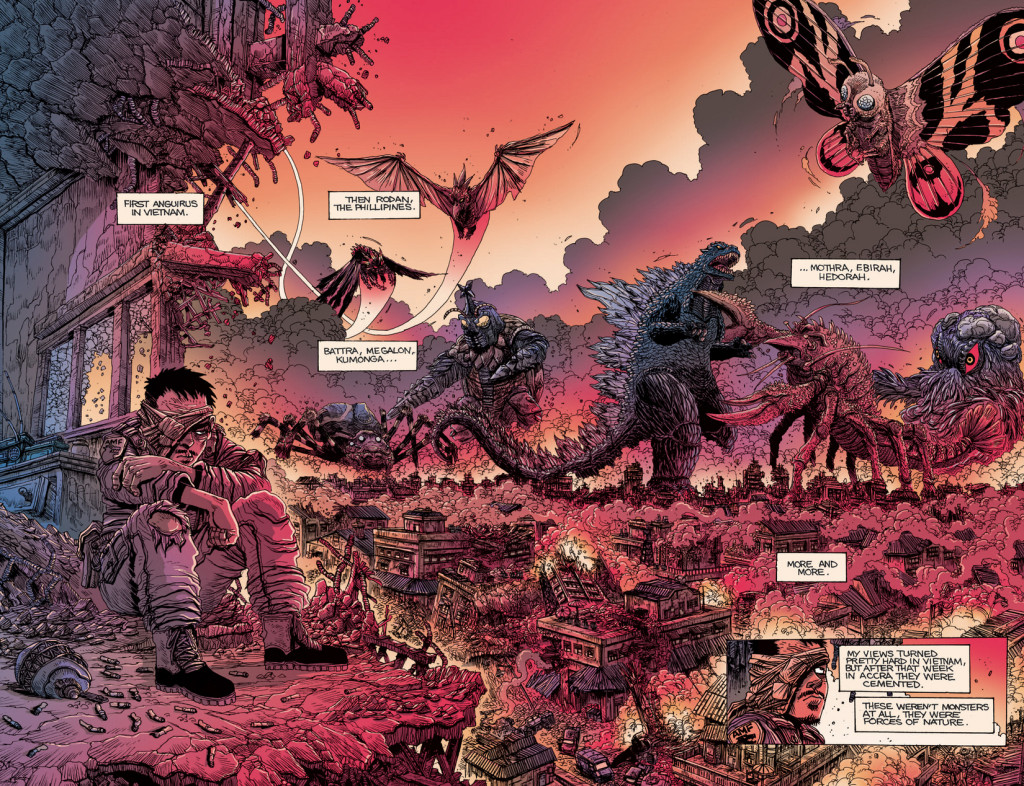
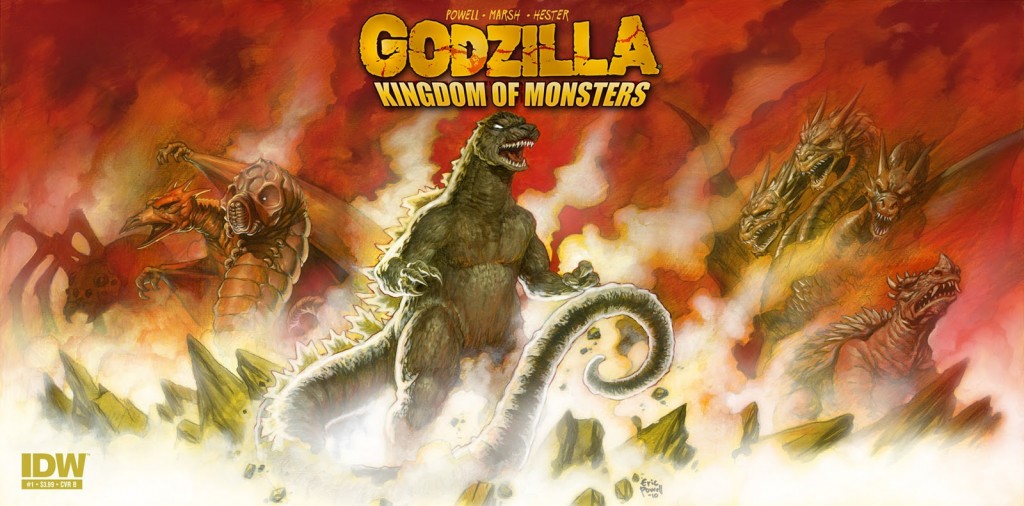
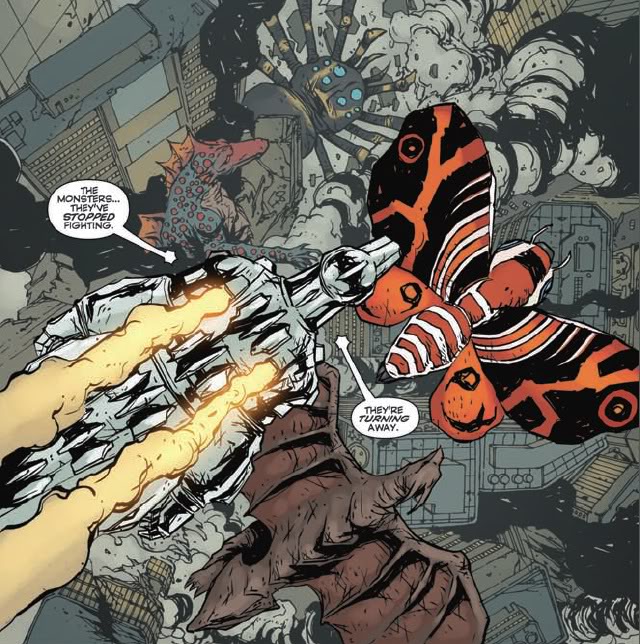

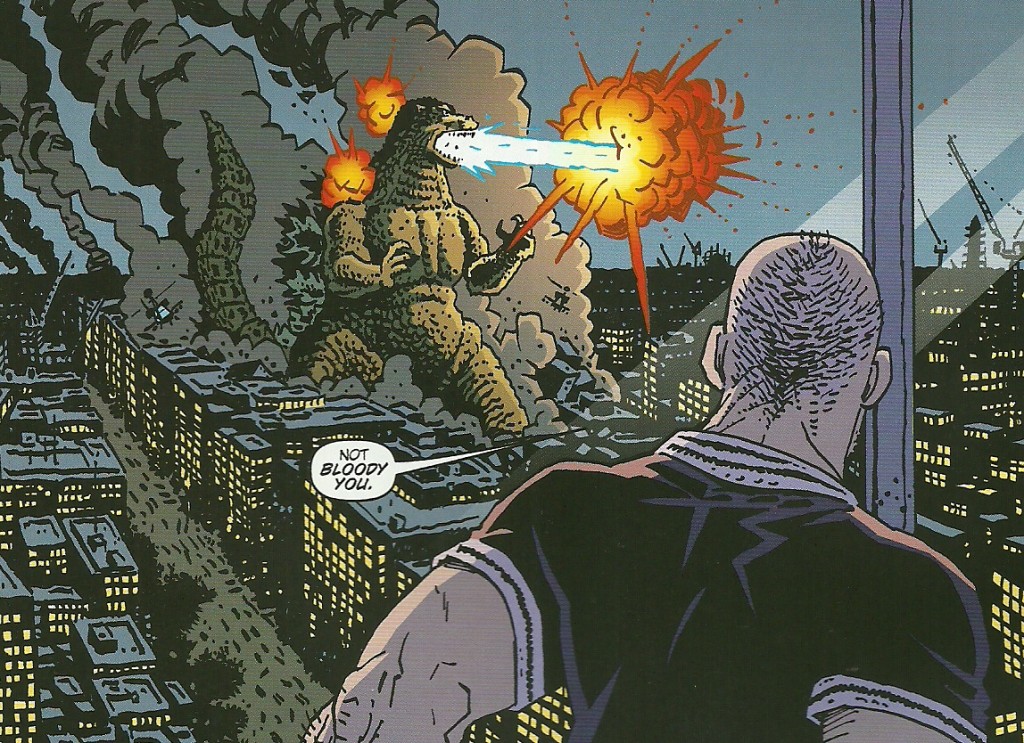
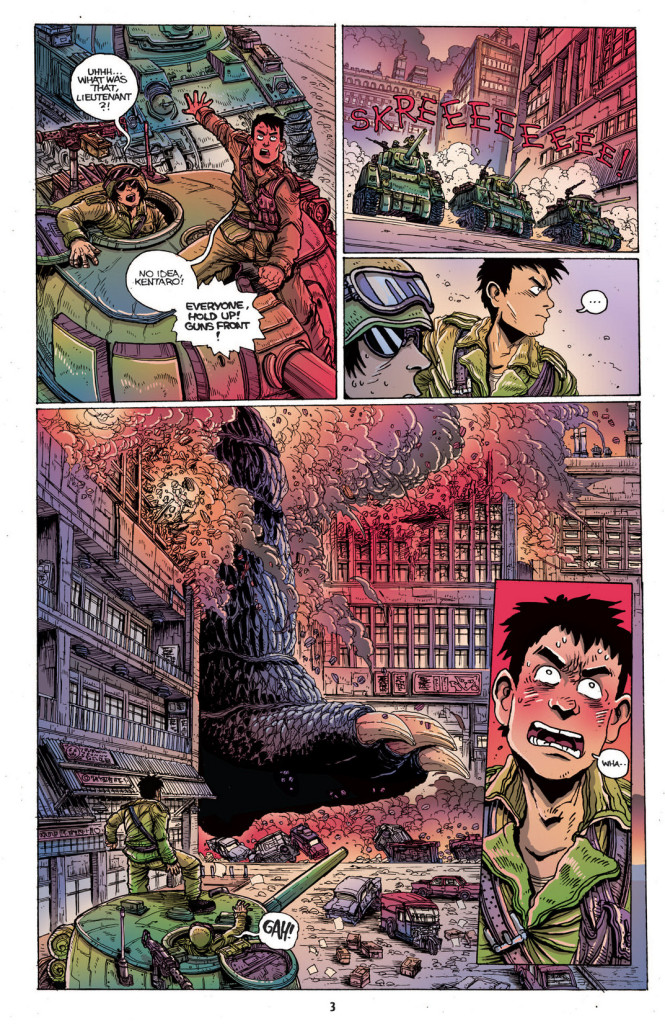
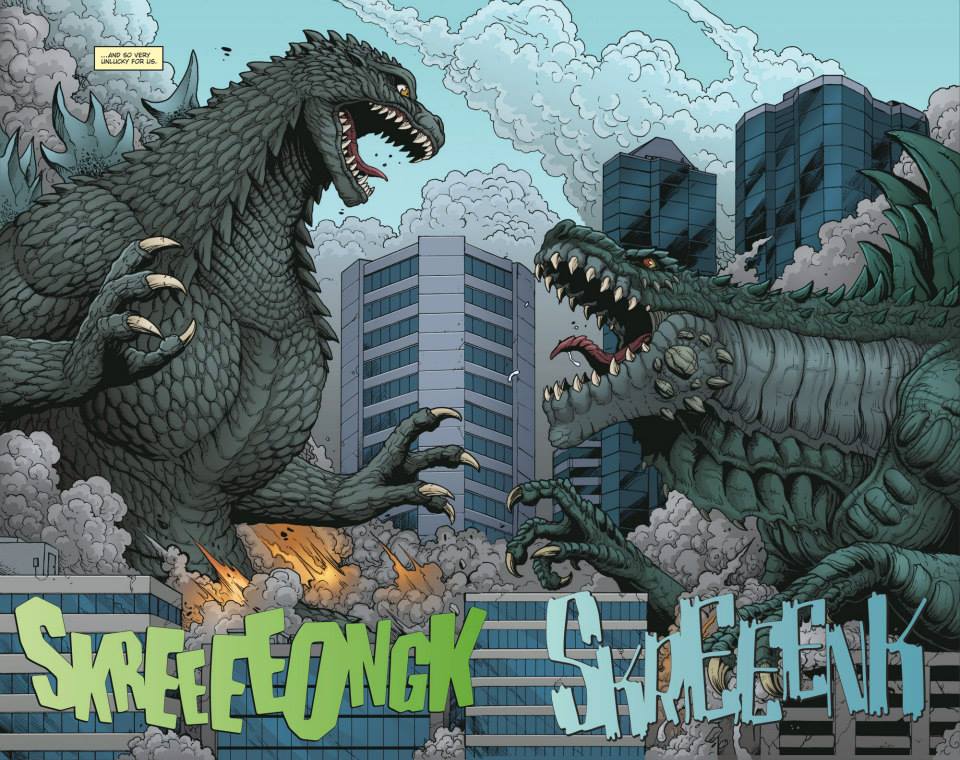

Thoughtfully written and highly informative analysis for someone who hasn’t been following Godzilla for sometime. Recommended to those who want to catch up and are interested in IDW’s take on a classic.